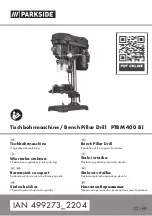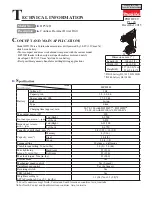
6
ENGLISH
Electrical safety
This tool is double insulated; therefore no earth
wire is required. Always check that the power
supply corresponds to the voltage on the rating
plate.
• If the supply cord is damaged, it must be replaced by the
manufacturer or an authorised STANLEY Service Centre
in order to avoid a hazard.
Features
This tool includes some or all of the following features.
1. Variable speed switch
2. Lock-on button
3. Forward/reverse button
4. Drilling mode selector
5. Chuck
The following accessories may not be available with your
unit
6. Depth stop
7 Side handle (STDH6513 only)
Assembly
Warning! Before assembly, make sure that the tool is
switched off and unplugged
Fitting the side handle and depth stop (fig. A, B)
• Turn the grip counter clockwise until you can slide the
side handle (7) onto the front of the tool as shown
(fig. A).
• Rotate the side handle into the desired position.
• Insert the depth stop (6) into the mounding hole as
shown (Fig.B)
• Set the drilling depth as described below.
• Tighten the side handle by tuming the grip clockwise.
Fitting a drill bit (Fig.C)
• Open the chuck by turning the sleeve (5) counter
clockwise.
• Insert the bit shaft (9) into the chuck ( drill bit not
included)
• Insert the chuck key (10) into each hole (8) in the side of
the chuck and turn clockwise until it is tight.
Removing and refitting the chuck (Fig.D)
• Open the chuck as far as possible.
• Remove the chuck retaining screw, located in the chuck,
by turning it clockwise using a screwdriver.
• Tighten an Allen key. Remove the chuck by turning it
counter clockwise.
• To refit the chuck, screw it onto the spindle and secure it
with the chuck retaining screw.
Residual risks
Additional residual risks may arise when using the tool which
may not be included in the enclosed safety warnings. These
risks can arise from misuse, prolonged use etc.
Even with the application of the relevant safety regulations
and the implementation of safety devices, certain residual
risks cannot be avoided. These include:
• Injuries caused by touching any rotating/moving parts.
• Injuries caused when changing any parts, blades or
accessories.
• Injuries caused by prolonged use of a tool. When using
any tool for prolonged periods make sure you take
regular breaks.
• Impairment of hearing.
• Health hazards caused by breathing dust developed
when using your tool (example:- working with wood,
especially oak, beech and MDF).
USE
Warning! Let the tool work at its own pace. Do not
overload.
Warning! Before drilling into walls , floors or
ceilings, check for the location of wiring and pipes.
Selecting the direction of rotation (fig.E)
For drilling and for tightening screws, use forward
(clockwise) rotation. For loosening screws or removing a
jammed drill bit, use reverse (counter clockwise) rotation.
• To select forward rotation, push the forward/ reverse
button (3) to the left position.
• To select reverse rotation, push the forward /reverse
button to the right. Warning! Never change the direction
of rotation while the motor is running.
Selecting the drilling mode
• For drilling in masonry, set the drilling mode selector (4)
to the position.
• For drilling in other materials and for screwdriving, set
the drilling mode selector to the position.
(Original instructions)



























